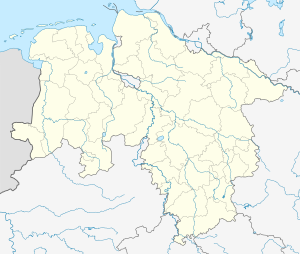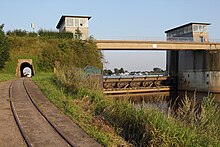Langwedel barrage
| Langwedel barrage | ||
|---|---|---|
| Langwedel barrage seen from the upper water with weir (right) and run-of-river power plant (left) | ||
| location | ||
|
|
||
| Coordinates | 52 ° 57 '50 " N , 9 ° 9' 11" E | |
| country |
|
|
| place | Intschede , Langwedel | |
| Waters | Weser | |
| Kilometers of water | km 329.396 | |
| Height upstream | 10 m above sea level NN | |
| power plant | ||
| owner | Statkraft | |
| operator | Statkraft | |
| Start of operation | 1958 | |
| technology | ||
| Bottleneck performance | 7.2 megawatts | |
| Average height of fall |
2.2 m | |
| Expansion flow | 292 m³ / s | |
| Standard work capacity | 41 million kWh / year | |
| Turbines | 4 Kaplan turbines | |
| Others | ||
| was standing | 2015 | |
The Langwedel barrage is one of seven barrages in the Mittelweser, which consist of a weir and a hydroelectric power station . It is located in a loop of water about 30 km upstream from the Bremen Weser power station near Langwedel in the Verden district in Lower Saxony . The Langwedel lock is located in the lock canal that was created for shipping and shortens some river loops . The weir system is intended to guarantee a fairway depth of at least 2.50 m for shipping in the Mittelweser.
location
The Langwedel barrage is located at 329.4 km on the Weser between the towns of Intschede and Daverden . Motor vehicle traffic between the locations is height and weight limited via a traffic light control in one lane over the building. On the power station side there is a fish passage on the other side of the bank a transfer point for pleasure craft. For shipping there is a lock canal branching off just before the weir with the Langwedel lock.
history
The first preparatory work for the Langwedel barrage was carried out in 1934 on the basis of a resolution by the Reich Ministry for Transport, Labor, Agriculture and Food and the Prussian state government. The excavation of the lock canal at the Langwedel barrage was promoted with three million Reichsmarks. The barrage was completed after the Second World War in the 1950s, together with other dams on the Mittelweser, in order to keep the water level as constant as possible and thus make the river passable for large ships. The weir was built between 1953 and 1958 and is operated by the Verden Waterways and Shipping Office .
At the same time, a run-of-river power plant with a capacity of 7.2 MW was built, which has been in operation since 1958. The hydropower plant was originally operated by the PreußenElektra company, which later became part of the E.ON Group. Through an exchange of shares with the Norwegian energy company Statkraft , the latter has been the owner and operator of the power plant since January 1, 2009. A lock and a canal were built for shipping, shortening the route through the river.
technology
The weir of the Langwedel barrage is 110 m wide and consists of three weir fields with movable elements. In each of the towers standing between the weir fields there are motors that control the weir bodies. One weir field is 30 meters wide, the other two 40 meters. The weir bodies each consist of a 160-ton steel three-belt gate , which can be moved up and down to open or close the weir, and an overhead, 8-ton fish-bellied flap for fast and precise regulation of the headwater level to normally constant 10.00 m above sea level .
The weir receives its electricity for control from the neighboring run-of-river power station and is operated remotely from there. Only in the event of flooding does the local water and shipping authority take over the water flow. When the water level is extremely high, the three-belt sluice gate is pulled up to allow larger masses of water to pass through. A complete closing process of the electrically operated three-belt protection device takes about 80 minutes. In an emergency, it can be turned up or down by hand in 38 hours.
If the oxygen content of the Weser is too low in summer, ventilation can be increased by disconnecting a turbine in the power station and lowering a fish-bellied valve in the weir to increase the flow.
power plant
The power plant has four Kaplan turbines , has been in operation since 1958 and has a capacity of 7.2 MW. It supplied around 30 million kWh of electricity annually from 1960 to 1986, according to the operator Statkraft, the mean value in recent years has been 41 GWh with a flow through the turbines of 292 m³ / s, which corresponds to an average output of 4.7 MW . The gradient at medium water level is about 2.20 meters. When the amount of water increases in spring due to rainfalls and snowmelt , the gradient can decrease so much that it is no longer possible to generate energy. From around 1000 m³ / s, the slope of the Weser is practically zero and therefore the run-of-river power plant no longer supplies electricity due to its design. The power plant in Langwedel is monitored from a central control room, which is located in the Erzhausen pumped storage plant .
literature
- Karl Löbe: Company Mittelweser. A plant for the future of Bremen. Published by the Weserbund eV, Verlag HM Hauschild, Bremen 1960.
- Frank M. Rauch: The Weser barrage near Bremen: Framework conditions for a hydropower plant yesterday and today . Journal of Hydrology and Water Management , Volume 47, Issue 2, April 2003.
Individual evidence
- ↑ Karl Lobe: The Weser book, novel of a river . 1968, p. 135 .
- ↑ Press release on the exchange of shares by Statkraft from January 8, 2009. Accessed on June 19, 2013. ( Memento of the original from September 27, 2013 in the Internet Archive ) Info: The archive link was automatically inserted and not yet checked. Please check the original and archive link according to the instructions and then remove this notice.
- ^ WSA Verden: Weir Langwedel: Technical data , accessed on September 1, 2015.
- ↑ Always enough water under the Kiel weser-kurier from August 12, 2014, accessed on September 3, 2015
- ↑ Langwedel power plant at www.statkraft.com, accessed on September 1, 2015



